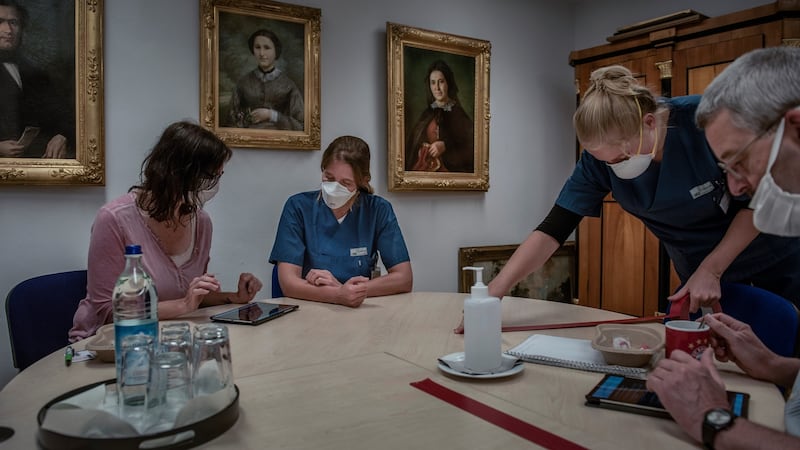Dr Camilla Rothe was about to leave for dinner when the government laboratory called with the surprising test result. Positive. It was January 27th. She had just discovered Germany's first case of the new coronavirus.
But the diagnosis made no sense. Her patient, a businessman from a nearby auto parts company, could have been infected by only one person: a colleague visiting from China. And that colleague should not have been contagious. The visitor had seemed perfectly healthy during her stay in Germany. No coughing or sneezing, no signs of fatigue or fever during two days of long meetings.
She told colleagues that she had started feeling ill after the flight back to China. Days later, she tested positive for the coronavirus.
Scientists at the time believed that only people with symptoms could spread the coronavirus. They assumed it acted like its genetic cousin, Sars. "People who know much more about coronaviruses than I do were absolutely sure," recalled Rothe, an infectious disease specialist at Munich University Hospital.
But if the experts were wrong – if the virus could spread from seemingly healthy carriers or people who had not yet developed symptoms – the ramifications were potentially catastrophic. Public awareness campaigns, airport screening and stay-home-if-you’re sick policies might not stop it.
More aggressive measures might be required: ordering healthy people to wear masks, for instance, or restricting international travel.
Rothe and her colleagues were among the first to warn the world. But even as evidence accumulated from other scientists, leading health officials expressed unwavering confidence that symptomless spreading was not important. In the days and weeks to come, politicians, public health officials and rival academics disparaged or ignored the Munich team.
Some actively worked to undermine the warnings at a crucial moment, as the disease was spreading unnoticed in French churches, Italian football stadiums and Austrian ski bars. A cruise ship, the Diamond Princess, would become a deadly harbinger of symptomless spreading.
Semantic debate
Interviews with doctors and public health officials in more than a dozen countries show that for two crucial months – and in the face of mounting genetic evidence – Western health officials and political leaders played down or denied the risk of symptomless spreading.
Leading health agencies including the World Health Organisation and the European Center for Disease Prevention and Control provided contradictory and sometimes misleading advice. A crucial public health discussion devolved into a semantic debate over what to call infected people without clear symptoms.
The two-month delay was a product of faulty scientific assumptions, academic rivalries and, perhaps most important, a reluctance to accept that containing the virus would take drastic measures. The resistance to emerging evidence was one part of the world’s sluggish response to the virus.
It is impossible to calculate the human toll of that delay, but models suggest that earlier, aggressive action might have saved tens of thousands of lives. Countries such as Singapore and Australia, which used testing and contact tracing and moved swiftly to quarantine seemingly healthy travellers, fared far better than those that did not.
It is now widely accepted that seemingly healthy people can spread the virus, though uncertainty remains over how much they have contributed to the pandemic. Although estimates vary, models using data from Hong Kong, Singapore and China suggest 30 per cent to 60 per cent of spreading occurs when people have no symptoms.
“This was, I think, a very simple truth,” Rothe said. “I was surprised that it would cause such a storm. I can’t explain it.”

Even now, with more than nine million cases around the world and a death toll approaching 500,000, Covid-19 remains an unsolved riddle. It is too soon to know whether the worst has passed or if a second global wave of infections is about to crash down. But it is clear that an array of countries, from secretive regimes to overconfident democracies, have fumbled their response, misjudged the virus and ignored their own emergency plans.
It is also painfully clear that time was a critical commodity in curbing the virus – and that too much of it was wasted.
Mild symptoms
On the night of Germany's first positive test, the virus had seemed far away. Fewer than 100 fatalities had been reported worldwide. Italy, which would become Europe's ground zero, would not record its first cases for another three days.
A few reports out of China had already suggested the possibility of symptomless spreading. But nobody had proved it could happen. That night, Rothe tapped out an email to a few dozen doctors and public health officials. “Infections can actually be transmitted during the incubation period,” she wrote.
Three more employees from the auto parts company, Webasto, tested positive the following day. Their symptoms were so mild that, normally, it's likely that none would have been flagged for testing or would have thought to stay at home.
Rothe decided she had to sound the alarm. Her boss, Dr Michael Hoelscher, dashed off an email to the New England Journal of Medicine. "We believe that this observation is of utmost importance," he wrote.
Editors responded immediately. How soon could they see the paper? The next morning, January 30th, public health officials interviewed the Chinese businesswoman by phone. Hospitalised in Shanghai, she explained that she had started feeling sick on the flight home. Looking back, maybe she had had some mild aches or fatigue, but she had chalked them up to a long day of travel.
"From her perspective, she was not ill," said Nadine Schian, a Webasto spokeswoman who was on the call. "She said, 'okay, I felt tired. But I've been in Germany a lot of times before, and I always have jet lag'."

When the health officials described the call, Rothe and Hoelscher quickly finished and submitted their article. Rothe did not talk to the patient herself but said she relied on the health authority summary. Within hours, it was online. It was a modest clinical observation at a key time.
Just days earlier, the World Health Organisation had said it needed more information about this very topic. What the authors did not know, however, was that in a suburb 20 minutes away, another group of doctors had also been rushing to publish a report. Neither knew what the other was working on, a seemingly small academic rift that would have global implications.
Similar conclusions
The second group was made up of officials with the Bavarian health authority and Germany's national health agency, known as the Robert Koch Institute. Inside a suburban office, doctors unfurled mural paper and traced infection routes using coloured pens.
Their team, led by Bavarian epidemiologist Dr Merle Böhmer, submitted an article to the Lancet, another premier medical journal. But the Munich hospital group had scooped them by three hours. Böhmer said her team's article, which went unpublished as a result, had reached similar conclusions but worded them slightly differently.
Rothe had written that patients appeared to be contagious before the onset of any symptoms. The government team had written that patients appeared to be contagious before the onset of full symptoms – at a time when symptoms were so mild that people might not even recognise them.
The Chinese woman, for example, had woken up in the middle of the night feeling jet-lagged. Wanting to be sharp for her meetings, she took a Chinese medicine called 999 – containing the equivalent of a Tylenol tablet – and went back to bed. Perhaps that had masked a mild fever? Perhaps her jet lag was actually fatigue? She had reached for a shawl during a meeting. Maybe that was a sign of chills?
After two lengthy phone calls with the woman, doctors at the Robert Koch Institute were convinced that she had simply failed to recognise her symptoms. They wrote to the editor of the New England Journal of Medicine, casting doubt on Rothe’s findings.
Editors there decided that the dispute amounted to hairsplitting. If it took a lengthy interview to identify symptoms, how could anyone be expected to do it in the real world? "The question was whether she had something consistent with Covid-19 or that anyone would have recognised at the time was Covid-19," said Dr Eric Rubin, the journal's editor. "The answer seemed to be no."
The journal did not publish the letter. But that would not be the end of it.
That weekend, Andreas Zapf, head of the Bavarian health authority, called Hoelscher of the Munich clinic. "Look, the people in Berlin are very angry about your publication," Zapf said, according to Hoelscher. He suggested changing the wording of Rothe's report and replacing her name with those of members of the government task force, Hoelscher said. He refused.
The health agency would not discuss the phone call. Until then, Hoelscher said, their report had seemed straightforward. Now it was clear: “Politically, this was a major, major issue.”
‘Complete tsunami’
On Monday, February 3rd, the journal Science published an article calling Rothe’s report “flawed”. Science reported that the Robert Koch Institute had written to the New England Journal to dispute her findings and correct an error. The Robert Koch Institute declined repeated interview requests over several weeks and did not answer written questions.
Rothe’s report quickly became a symbol of rushed research. Scientists said she should have talked to the Chinese patient herself before publishing and that the omission had undermined her team’s work. On Twitter, she and her colleagues were disparaged by scientists and armchair experts alike.

"It broke over us like a complete tsunami," Hoelscher said. The controversy also overshadowed another crucial development out of Munich. The next morning, Dr Clemens-Martin Wendtner made a startling announcement. Wendtner was overseeing treatment of Munich's Covid-19 patients – there were eight now – and had taken swabs from each.
He discovered the virus in the nose and throat at much higher levels, and far earlier, than had been observed in patients with severe acute respiratory syndrome (Sars). That meant it probably could spread before people knew they were sick.
But the Science story drowned that news out. If Rothe’s paper had implied that governments might need to do more against Covid-19, the pushback from the Robert Koch Institute was an implicit defence of the conventional thinking.
Sweden’s public health agency declared that Rothe’s report had contained major errors. The agency’s website said, unequivocally, that “there is no evidence that people are infectious during the incubation period” – an assertion that would remain online in some form for months.
French health officials, too, left no room for debate: “A person is contagious only when symptoms appear,” a government flyer read. “No symptoms = no risk of being contagious.”
As Rothe and Hoelscher reeled from the criticism, Japanese doctors were preparing to board the Diamond Princess cruise ship. A former passenger had tested positive for coronavirus. Yet on the ship, parties continued. The infected passenger had been off the ship for days, after all. And he hadn’t reported symptoms while on board.
Semantic distinction
Immediately after Rothe’s report, the World Health Organisation had noted that patients might transmit the virus before showing symptoms. But the organisation also underscored a point that it continues to make: Patients with symptoms are the main drivers of the epidemic.
Once the Science paper was published, however, the organisation waded directly into the debate on Rothe's work. On Tuesday, February 4th, Dr Sylvie Briand, the agency's chief of infectious disease preparedness, tweeted a link to the Science paper, calling Rothe's report flawed.
With that tweet, the WHO focused on a semantic distinction that would cloud discussion for months: Was the patient asymptomatic, meaning she would never show symptoms? Or presymptomatic, meaning she became sick later? Or, even more confusing, oligo-symptomatic, meaning that she had symptoms so mild that she didn’t recognise them?
To some doctors, the focus on these arcane distinctions felt like whistling in the graveyard. A person who feels healthy has no way to know that she is carrying a virus or is about to become sick. Airport temperature checks will not catch these people. Neither will asking them about their symptoms nor telling them to stay home when they feel ill.
The WHO later said that the tweet had not been intended as a criticism.
One group paid little attention to this brewing debate: the Munich-area doctors working to contain the cluster at the auto parts company. They spoke daily with potentially sick people, monitoring their symptoms and tracking their contacts.
"For us, it was pretty soon clear that this disease can be transmitted before symptoms," said Dr Monika Wirth, who tracked contacts in the nearby county of Fürstenfeldbruck. Rothe, though, was shaken. She could not understand why much of the scientific establishment seemed eager to play down the risk.
“All you need is a pair of eyes,” she said. “You don’t need rocket-science virology.” But she remained confident. “We will be proven right,” she told Hoelscher.
That night, Rothe received an email from Dr Michael Libman, an infectious disease specialist in Montreal. He thought that criticism of the paper amounted to semantics. Her paper had convinced him of something: "The disease will most likely eventually spread around the world."
Startling call
On February 4th, Britain’s emergency scientific committee met and, while its experts did not rule out the possibility of symptomless transmission, nobody put much stock in Rothe’s paper.
"It was very much a hearsay study," said Wendy Barclay, a virologist and member of the committee, known as the Scientific Advisory Group for Emergencies. "In the absence of real robust epidemiology and tracing, it isn't obvious until you see the data."

The data would soon arrive, and from an unexpected source. Böhmer, from the Bavarian health team, received a startling phone call in the second week of February.
Virologists had discovered a subtle genetic mutation in the infections of two patients from the Munich cluster. They had crossed paths for the briefest of moments, one passing a saltshaker to the other in the company cafeteria, when neither had symptoms. Their shared mutation made it clear that one had infected the other.
Böhmer had been sceptical of symptomless spreading. But now there was no doubt: “It can only be explained with presymptomatic transmission,” Böhmer said. Now it was Böhmer who sounded the alarm. She said she promptly shared the finding, and its significance, with the WHO and the European Centre for Disease Prevention and Control.
Neither organisation included the discovery in its regular reports.
A week after receiving Böhmer’s information, European health officials were still declaring, “We are still unsure whether mild or asymptomatic cases can transmit the virus.” There was no mention of the genetic evidence. WHO officials said the genetic discovery informed their thinking, but they made no announcement of it.
European health officials said the German information was one early piece of an emerging picture that they were still piecing together. The doctors in Munich were increasingly frustrated and confused by the WHO. First, the group wrongly credited the Chinese government with alerting German authorities to the first infection. Government officials and doctors said the auto parts company itself sounded the alarm.
Then, the WHO's emergency director, Dr Michael Ryan, said on February 27th that the significance of symptomless spreading was becoming a myth. And Dr Maria Van Kerkhove, the organisation's technical lead on the coronavirus response, suggested it was nothing to worry about.
“It’s rare but possible,” she said. “It’s very rare.” The agency still maintains that people who cough or sneeze are more contagious than people who don’t. But there is no scientific consensus on how significant this difference is or how it affects the spread of virus.
And so, with evidence mounting, the Munich team could not understand how the WHO could be so sure that symptomless spreading was insignificant. “At this point, for us it was clear,” said Wendtner, the senior doctor overseeing treatment of the Covid-19 patients. “This was a misleading statement by the WHO.”
Silent spreaders
The Munich cluster was not the only warning. Chinese health authorities had explicitly cautioned that patients were contagious before showing symptoms. A Japanese bus driver was infected while transporting seemingly healthy tourists from Wuhan, China. And by the middle of February, 355 people aboard the Diamond Princess cruise ship had tested positive. About one-third of the infected passengers and staff had no symptoms.

Public health officials saw danger in promoting the risk of silent spreaders. If quarantining sick people and tracing their contacts could not reliably contain the disease, governments might abandon those efforts altogether.
In Sweden and Britain, for example, discussion swirled about enduring the epidemic until the population obtained "herd immunity". Public health officials worried that might lead to overwhelmed hospitals and needless deaths. Plus, preventing silent spreading required aggressive, widespread testing that was then impossible for most countries.
“It’s not like we had some easy alternative,” said Libman, the Canadian doctor. “The message was basically, ‘If this is true, we’re in trouble’.”
European health officials said they were reluctant to acknowledge silent spreading because the evidence was trickling in and the consequences of a false alarm would have been severe. "These reports are seen everywhere, all over the world," said Dr Josep Jansa, a senior European Union health official. "Whatever we put out, there's no way back."
Looking back, health officials should have said that, yes, symptomless spreading was happening and they did not understand how prevalent it was, said Dr Agoritsa Baka, a senior EU doctor. But doing that, she said, would have amounted to an implicit warning to countries: What you're doing might not be enough.
While public health officials hesitated, some doctors acted. At a conference in Seattle in mid-February, Jeffrey Shaman, a Columbia University professor, said his research suggested Covid-19's rapid spread could be explained only if there were infectious patients with unremarkable symptoms or no symptoms at all.
In the audience that day was Steven Chu, the Nobel-winning physicist and former US energy secretary. "If left to its own devices, this disease will spread through the whole population," he remembers Shaman warning.
Afterwards, Chu began insisting that healthy colleagues at his Stanford University laboratory wear masks. Doctors in Cambridge, England, concluded that asymptomatic transmission was a big source of infection and advised local health workers and patients to wear masks well before the British government acknowledged the risk of silent spreaders.
Spreading the disease
US authorities, faced with a shortage, actively discouraged the public from buying masks. "Seriously people ? STOP BUYING MASKS!", surgeon general Jerome Adams tweeted February 29th.
By early March, while the WHO continued pressing the case that symptom-free transmission was rare, science was breaking in the other direction. Researchers in Hong Kong estimated that 44 per cent of Covid-19 transmission occurred before symptoms began, an estimate that was in line with a British study that put that number as high as 50 per cent.
The Hong Kong study concluded that people became infectious about two days before their illness emerged, with a peak on their first day of symptoms. By the time patients felt the first headache or scratch in the throat, they might have been spreading the disease for days.
In Belgium, doctors saw that maths in action as Covid-19 tore through nursing homes, killing nearly 5,000 people. "We thought that by monitoring symptoms and asking sick people to stay at home, we would be able to manage the spread," said Steven Van Gucht, head of Belgium's Covid-19 scientific committee. "It came in through people with hardly any symptoms."
More than 700 people aboard the Diamond Princess were sickened. Fourteen died. Researchers estimate that most of the infection occurred early on, while seemingly healthy passengers socialised and partied. Government scientists in Britain concluded in late April that 5 per cent to 6 per cent of symptomless health care workers were infected and might have been spreading the virus.
In Munich, Hoelscher has asked himself many times whether things would have been different if world leaders had taken the issue seriously earlier. He compared their response to a rabbit stumbling upon a poisonous snake. “We were watching that snake and were somehow paralysed,” he said.
As the research coalesced in March, European health officials were convinced. “Okay, this is really a big issue,” Baka recalled thinking. “It plays a big role in the transmission.”
By the end of the month, the US Centers for Disease Control and Prevention announced it was rethinking its policy on masks. It concluded that up to 25 per cent of patients might have no symptoms. Since then, the CDC, governments around the world and, finally, the WHO have recommended that people wear masks in public.
Still, the WHO is sending confusing signals. Earlier this month, Van Kerkhove, the technical lead, repeated that transmission from asymptomatic patients was “very rare”. After an outcry from doctors, the agency said there had been a misunderstanding.
“In all honesty, we don’t have a clear picture on this yet,” Van Kerkhove said. She said she had been referring to a few studies showing limited transmission from asymptomatic patients.
Contact tracing
Recent internet ads confused the matter even more. A Google search in mid-June for studies on asymptomatic transmission returned a WHO advertisement titled "People With No Symptoms – Rarely Spread Coronavirus. "
Clicking on the link, however, offered a much more nuanced picture: “Some reports have indicated that people with no symptoms can transmit the virus. It is not yet known how often it happens.” After the New York Times asked about those discrepancies, the organisation removed the advertisements.
Back in Munich, there is little doubt left. Böhmer, the Bavarian government doctor, published a study in the Lancet last month that relied on extensive interviews and genetic information to methodically track every case in the cluster. In the months after Rothe swabbed her first patient, 16 infected people were identified and caught early. All survived.
Aggressive testing and flawless contact tracing contained the spread. Böhmer’s study found “substantial” transmission from people with no symptoms or exceptionally mild, nonspecific symptoms. Rothe and her colleagues got a footnote. – New York Times










